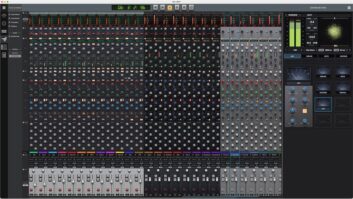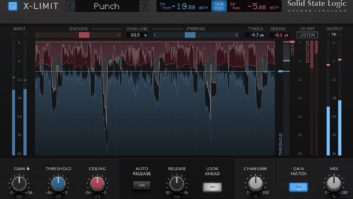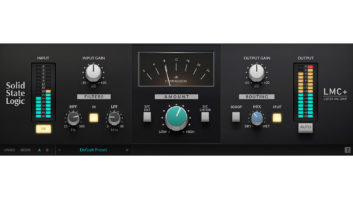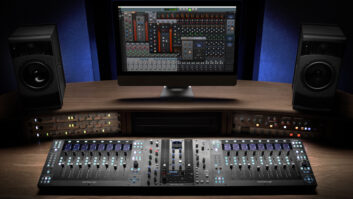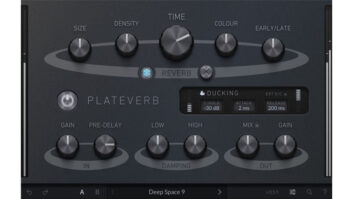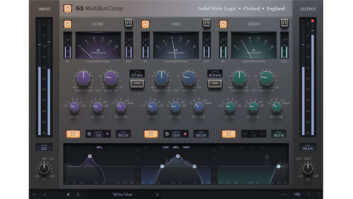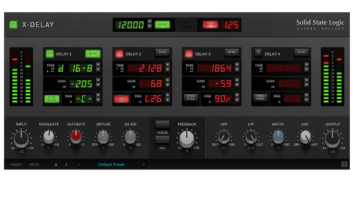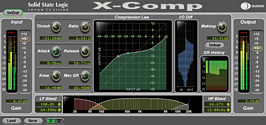
The X-Comp’s dual-symmetrical knee design allows detailed shaping of the compression characteristic.
Solid State Logic’s X-Comp is the latest plug-in for Duende, the company’s external DSP unit. Duende comes in three models: the original single-rackspace unit, Duende PCIe and Duende Mini, the new ⅓-rackspace unit. All three models connect to the host computer’s FireWire 400 bus. Duende plug-ins run on internal DSP chips that are based on SSL’s C Series digital consoles. Each chip is divided into eight “slots,” with X-Comp requiring one slot at 44.1/48 kHz in mono or two slots for stereo. Mini ships with 16 active slots and can be upgraded to 32 slots. Duende plugs are available in VST, Audio Units and RTAS (with wrapper) formats on PCs and Macs, and operate at 44.1/48/88.2/96kHz rates.
X-Comp is capable of many compressor modes and styles — from gentle and unobtrusive control to stricter, more confined dynamics and up to special effects that radically change tonality. This is accomplished with precision and resolution using two methods: dual-symmetrical compressor knees and frequency-dependent parallel compression.
PARALLEL PATH
X-Comp can pass input audio around the compressor through a frequency-dependent sidechain that uses first-order highpass/lowpass filters. You can stress certain frequencies with further compression while allowing other bands to pass though unaffected. With frequency controls at 30 to 300 Hz and 2 to 12k Hz, the filter will operate in highpass, lowpass or bandpass modes. The LF Bleed and HF Bleed blend controls mix any amount of the sidechain signal with the compressed signal to the final output. There is no filter-bypass button or Listen mode for hearing and tweaking this action in solo.
X-Comp has all the usual compressor suspects: threshold (-48 to +12 dB), ratio (1:1 to 50:1), attack (0.5 to 100 ms), release (1 ms to 2 seconds) and makeup gain (-6 to +36 dB). Most impressive on the GUI is the Compression Law display, an I/O transfer-function graph that changes shape with parameter changes.
A GR History shows gain reduction and recent gain-reduction values. Another amplitude histogram, I/O Difference, displays a brief history of input peaks vs. post-compression output peaks. I like this display, but I wish it was wider with greater resolution. Input and output level meters include peak-overload indicators and a moving pair of white brackets showing the upper and lower values (in dB) of the dynamic ranges of input and output levels.
UP AND RUNNING
A few caveats for Duende users: Do not run other FireWire devices or drives along with Duende. Pro Tools users will have to lengthen the H/W buffer size depending on the number of running RTAS plug-ins. Install only the RTAS installer; if you run a VST-RTAS wrapper for other plugs, verify that the wrapper has not surreptitiously wrapped the SSL VST plug-in versions.
I ran X-Comp on a quad-core Mac G5 running OS 10.4.11 and Pro Tools Version 7.4cs2. Duende launches from the plug-in list like any other plug. X-Comp has the standard plug-in GUI with a full complement of parameter automation choices. Loading and saving presets happens within the plug-in’s GUI, and X-Comp operation was identical at 44.1 and 96 kHz.
I particularly liked using X-Comp for extreme, wild compression effects. Unlike most compressors (including hardware units), X-Comp lets you apply vast amounts of gain reduction and high ratios without experiencing unwanted artifacts and distortion. X-Comp’s preset collection favors special effects and offers plenty of starting points for experimentation. I also liked using the A/B feature to quickly compare two different setups; toggling between them worked seamlessly, although I wish this process could be automated.
As a simplified multiband compressor, X-Comp is hard to beat. I liked it as a stereo bus compressor, letting the high frequencies pass without compression for a more open sound. If your mix is intentionally bass-heavy, you can keep the bottom from modulating gain reduction by using the LF Bleed feature. I could squash vocals to better effect by closing down the pass band so that compression only occurred on important midrange frequencies. This resulted in a warmer vocal sound but with good control, open highs and less of a dulling effect.
Loop processing is endless fun: You can nearly “remix” the loop with presets called Crisp Snare or Punchy BD. You can use superhigh ratios to get outrageous rhythmic pumping effects.
IN RESERVE
X-Comp is sold exclusively through SSL’s Website for $499. It is an excellent tool and a worthwhile addition to your Duende processor. Reserve it for extremely tough dynamics problems or for creating a special, one-of-a-kind effect.
Solid State Logic, www.solid-state-logic.com.
Barry Rudolph is an L.A.-based recording engineer/mixer. Visit
www.barryrudolph.com.
